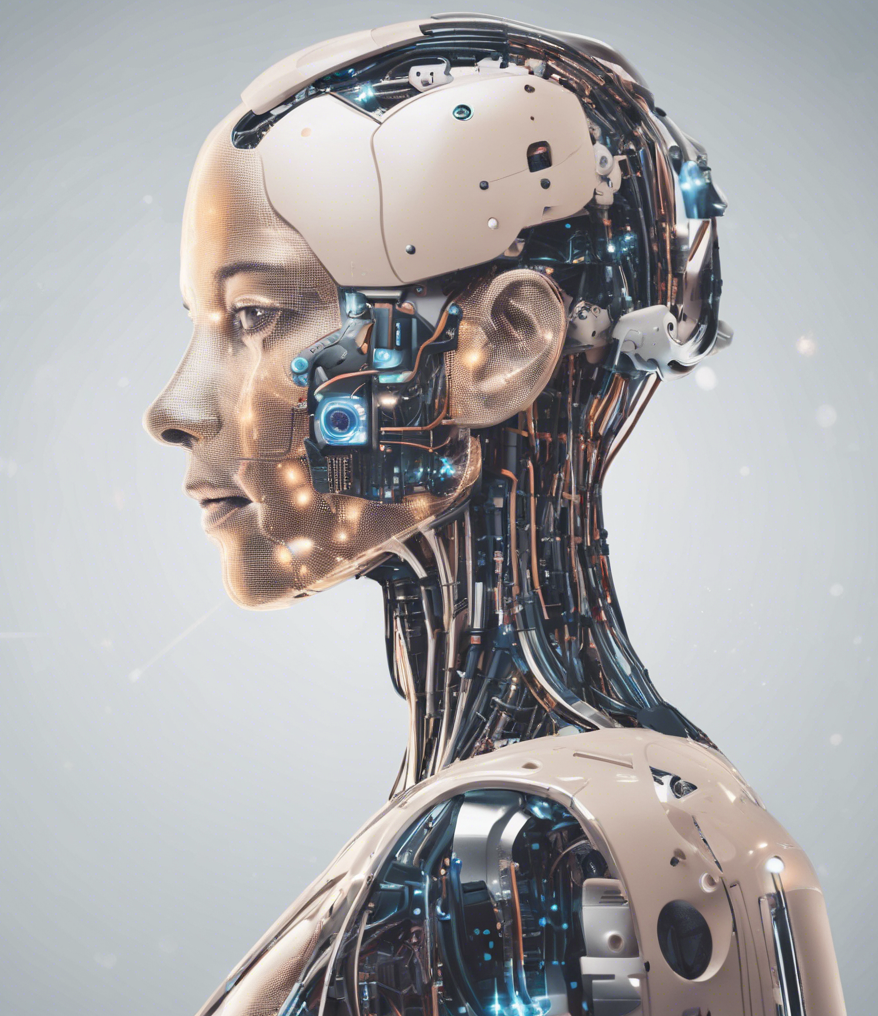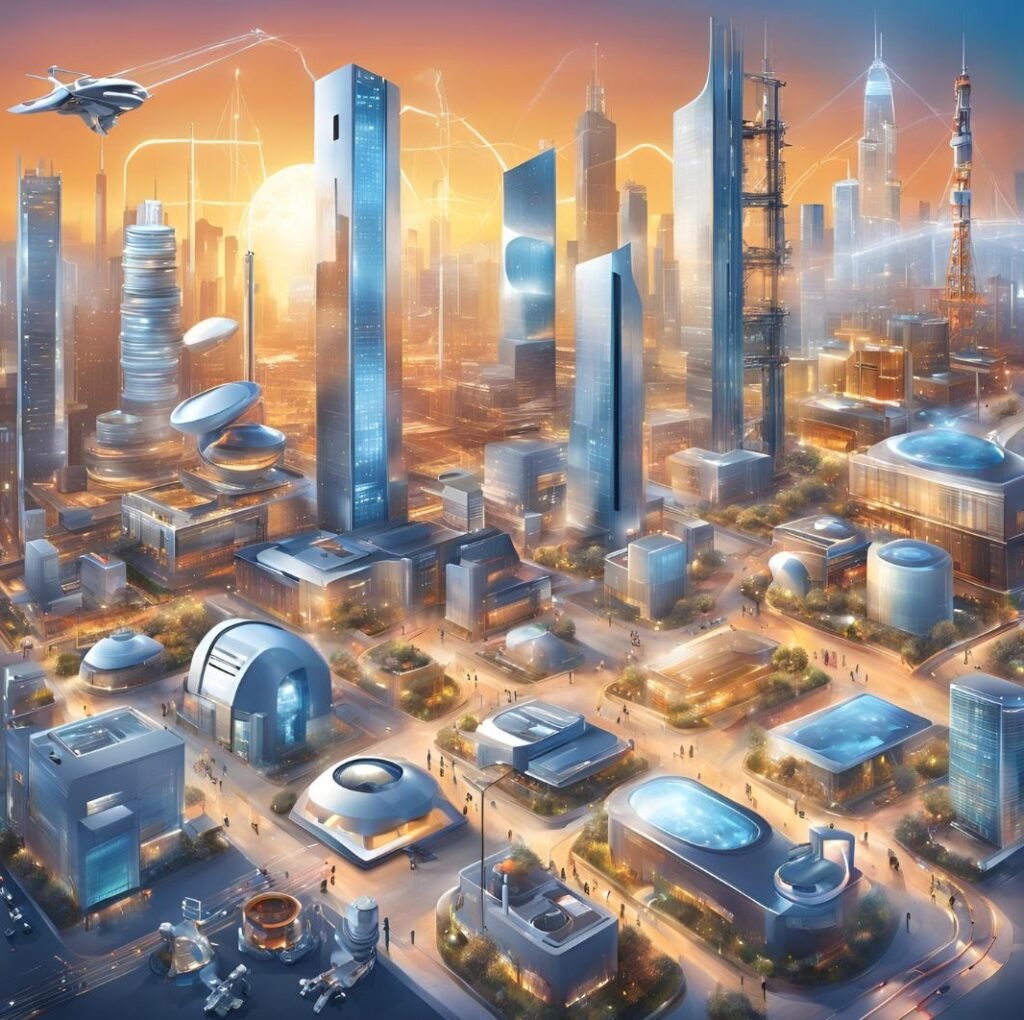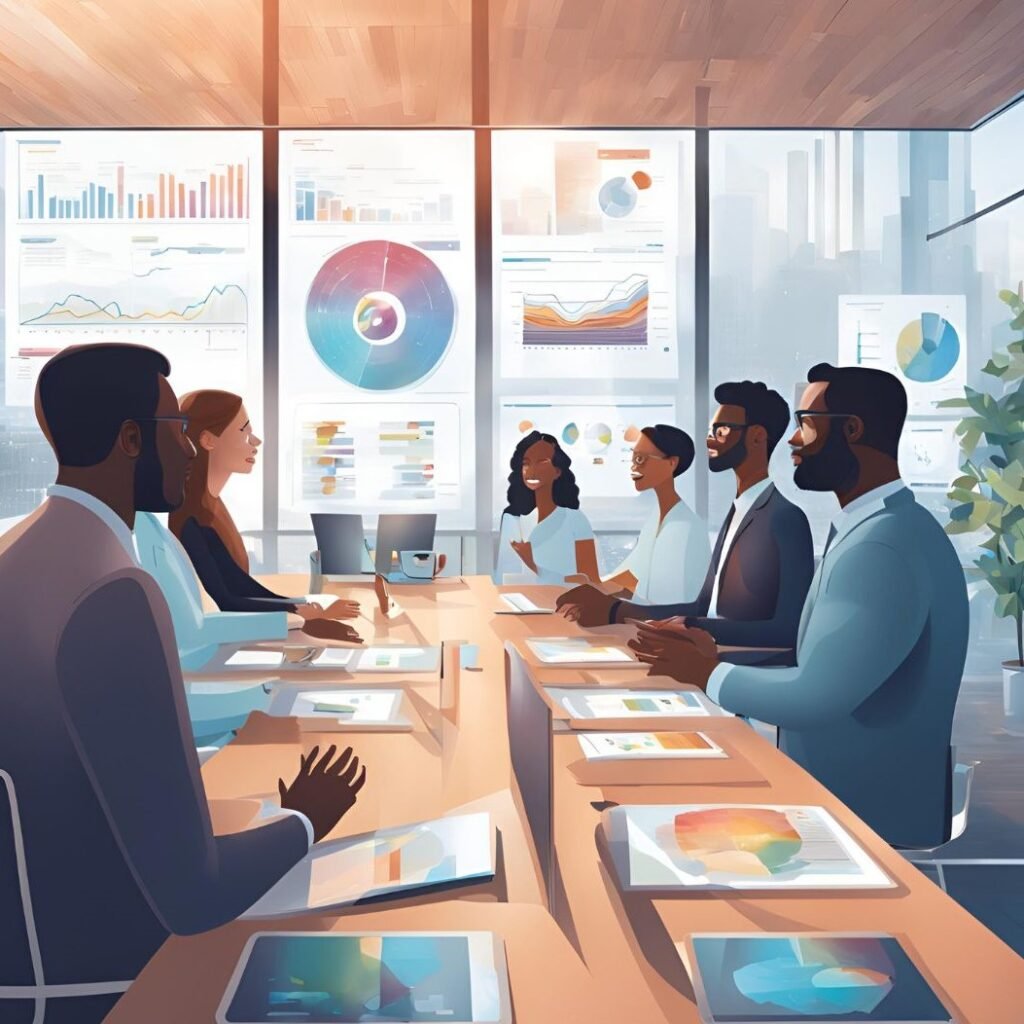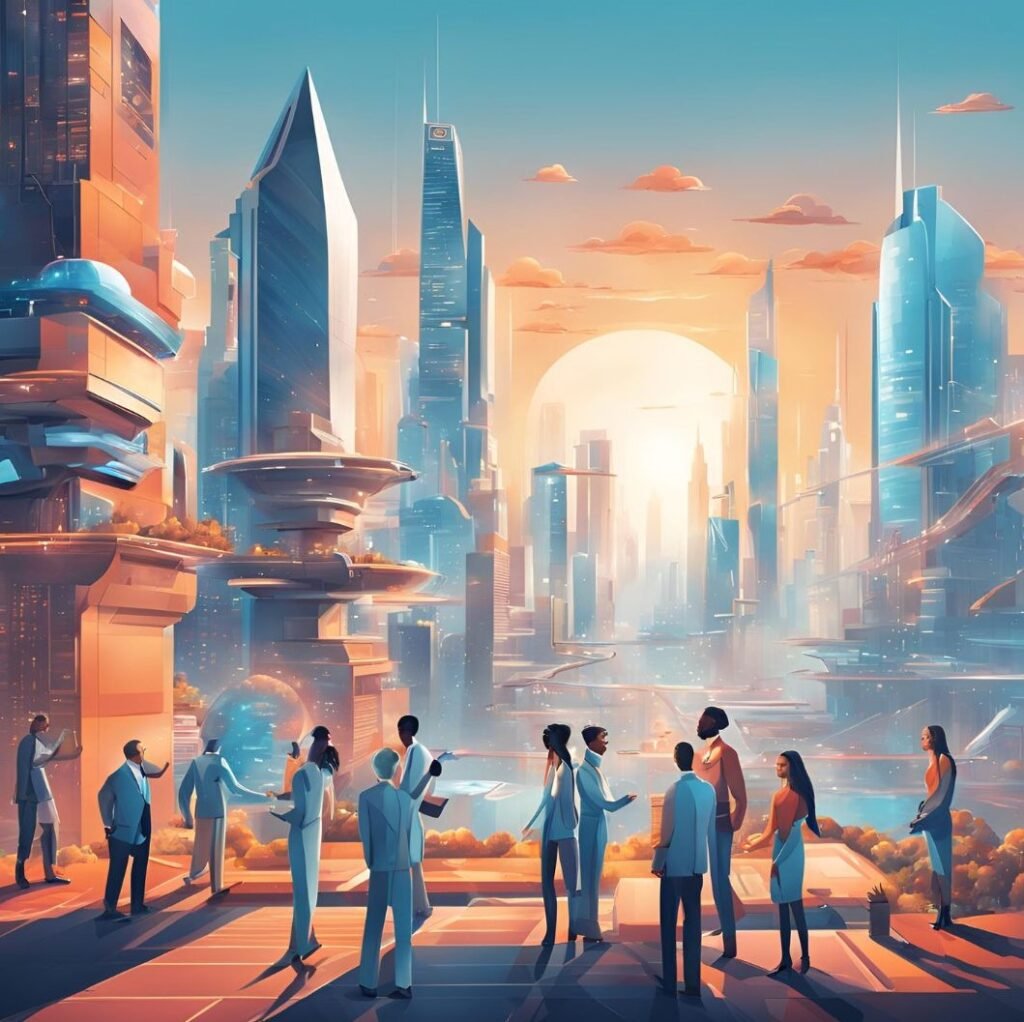The present day industries and employment markets have been heavily impacted as a result of its swift shift from a futuristic concept to an important force. Regular duties advantages be accomplished or new methods of business created, this will definitely change our lives for the better. The question that looms large is:

Table of Contents
ToggleHow will AI impact jobs and industries?
We will see in this blog post how AI will greatly influence the job market and whole sectors. Better productivity and innovations are some of the amazing advantages brought about by artificial intelligence but at the same time it causes major setbacks such as displacement of employees, need for further training and increasing concerns on the future of labor.
1- AI and Job Automation: The Reality of Job Displacement
Automating jobs is usually the first topic of conversation when talking about how AI has affected jobs. AI, coupled with machine learning, robotic process automation (RPA), and advanced algorithms, can perform repetitive, rules-based tasks that were traditionally done by humans.

1.1- Jobs Most Susceptible to Automation
In particular, certain job roles are more adaptable to AI-driven automation, for instance those that encompass customary assignments, redundant approaches, and a little human touch. Prime economic sectors and occupational categories vulnerable to this are:
- Manufacturing and Assembly Line Jobs: Robotic systems powered by AI have already replaced many manual labor jobs in manufacturing. Tasks such as welding; assembly; and quality control have all become specific activities that robots can perform with great precision.
- Retail Cashiers and Sales Associates: AI-driven self-checkout systems and e-commerce platforms are reducing the need for human cashiers and sales staff.
- Transportation: Autonomous vehicles are advancing rapidly, potentially displacing truck drivers, delivery personnel, and taxi drivers in the near future.
- Data Entry and Routine Administrative Tasks: AI can process large amounts of data quickly, making data entry clerks and administrative assistants vulnerable to automation.
In a report released in 2020, the World Economic Forum predicted that there could be 85 million jobs lost through AI and automation by 2025. Furthermore, this highlighted presence of 97 million additional job openings in AI field, data analytics as well other advanced tech industries.
1.2- The Role of AI in Job Creation
While automation will undoubtedly displace certain jobs, AI is also expected to create entirely new roles that didn’t exist a decade ago. The employment characteristics have turned around, and thus call for occupations that consist of administering, improving and making better AI devices. For instance:
- AI Specialists and Engineers: In recent times, AI has taken a central role in the universe of technology; thus we have more and more people in the fields of artificial intelligence engineering, data science and machine learning who are responsible for developing AI systems and verifying their workability.
- Data Analysts and Data Scientists: More and more, specialists with the ability to comprehend information, understand insights obtained through Artificial Intelligence (AI), in order formulate tactical moves for enterprises are required.
- Ethical AI Officers: As AI continues to evolve, businesses will need professionals dedicated to ensuring ethical AI usage, addressing biases, and implementing AI responsibly.
- AI Trainers and Supervisors: AI systems require training data, and some job roles will involve supervising AI performance and ensuring its proper functioning in specific environments.
2- Industries Poised for Transformation by AI

You’ve undergone a transformation in processes, business models as well as recipients showing great improvement in numerous fields rather than just being an artificial construction. For instance, various sections which are projected to be greatly affected by AI are discussed below:
You’ve undergone a transformation in processes, business models as well as recipients showing great improvement in numerous fields rather than just being an artificial construction. For instance, various sections which are projected to be greatly affected by AI are discussed below:
2.1- Healthcare
Improving diagnosis, treatment plans and patient outcomes are the potentials being mastered by AI in healthcare. Here are several instances among countless other instances of how healthcare is impacted by AI:
- Medical Diagnosis: AI algorithms are increasingly used to analyze medical images, identify patterns, and diagnose diseases like cancer, diabetes, and cardiovascular conditions more accurately and faster than traditional methods.
- Personalized Medicine: AI can analyze vast datasets of genetic information, medical history, and lifestyle factors to create tailored treatment plans for patients, leading to better outcomes.
- Robotic Surgery: With their precision triangulation, AI surgical robots help doctors operate with utmost accuracy leading to reduced errors and quicker recuperation for patients.
- Administrative Tasks: AI-Powered Systems handle scheduling, billing, and other routine administrative tasks, allowing healthcare professionals to focus more on patient care.
The use of AI in healthcare sector has also some concerns such as the moral use of patient’s information, the chances that AI may be biased and the danger of putting too much trust in machine-generated diagnosis.
2.2- Finance and Banking
Since the initial stages, AI has been utilized as a device within the monetary area. It simplifies everything for its clients through aiding them in fraud detection, process automation and enhancement of customer care service. The following are a few of the important uses:
- Fraud Detection and Risk Management: In comparison to conventional techniques, AI is capable of examining transactions in live time for determining any abnormal patterns or identifying possible fraud at much more accurate level due to its higher degree of precision.
- Algorithmic Trading: By means of AI-driven algorithms, financial institutions are able to execute extremely rapid trading decisions based on market data, minimizing human error and maximizing profits.
- Customer Service and Chatbots: To take help of a similar tool that backs us in our study or research often or one may say replicas, they are useful especially when dealing with questions like these which regular people ask. They do so by performing roles such as handling basic questions related to customer services like checking account balances and dispute resolution thereby releasing human beings for complicated jobs.
- Personal Finance Management: Several financial applications presently employs artificial intelligence to evaluate users’ spending behaviours and provide them with tailored recommendations for budgeting, thriftiness and investment.
With AI making things easier, there are fears of losing jobs in traditional banking such as loan officers, financial get hold of anybody state and customer support.
2.3- Retail
Unless there is an alternative, the retail environment is undergoing so much change through artificial intelligence as it improves customer satisfaction and simplifies procedures for shop owners.
- Personalized Shopping Experiences: AI algorithms analyze customer data to offer personalized product recommendations, improving the shopping experience and increasing sales.
- Inventory Management: AI-Driven systems help retailers optimize inventory levels, reduce waste, and forecast demand more accurately, ensuring products are available when needed.
- Automation of Checkout Processes: Self checkout systems and cashier less stores like Amazon Go are powered by AI and IoT (Internet of Things), allowing customers to make purchases without human intervention.
When working in the retail industry, AI tends to make things easier whereby services like cashiering and stock clerking would be minimized while new avenues such as those in e-commerce management, data analysis and customer service through artificial intelligence would emerge.
2.4- Education
The education industry is being changed by AI-driven program which aimed at enhancing student performance as well as administrative effectiveness.
- Personalized Learning: AI-Powered platforms analyze student performance and learning styles, creating personalized educational experiences that cater to individual needs.
- Automated Grading and Administrative Tasks: AI systems can handle repetitive tasks like grading assignments, scheduling, and tracking student progress, freeing up teachers to focus on instruction.
- Virtual Tutors: AI-driven virtual tutors provide real-time assistance to students, helping them understand complex concepts and offering supplemental learning.
Certainly, I understand most people may be skeptical in this regard but as much as introducing AI to education serves as an improvement, there is fear that some administrative and support staff may lose their jobs. Online education is hindering equal opportunities especially for those who cannot afford them and this has brought about several issues.
3- The Future of Work: Human AI Collaboration
All the same, the concerns about possibly dislocating some clerical and assistive jobs in addition to ensuring fair access to AI-based applications are valid. In an era of changing industries due to AIs, co-existing is becoming a new way of doing things; people and intelligent machines working together for greater results. In most cases, therefore immutable artificial intelligence will be an additional resource for man power with respect to tasks execution process, thereby improving its efficacy.

3.1- Augmentation V/s Automation
AI suits well in most situations involving lots of data processing or repetitive work but humans excel in creative thinking emotional intelligence and complex problem solving. The division of labor creates opportunities for human-ai collaboration where ai does the routine job while human beings concentrate on higher order thoughts.
For Example:
- In Healthcare: AI can analyze patient data to recommend treatment options, but doctors will still be needed to interpret the results and make final decisions based on patient preferences.
- In Education: AI may automate grading and administrative tasks, but teachers will continue to provide critical guidance, mentorship, and emotional support to students.
- In Manufacturing: AI-powered robots can perform repetitive assembly tasks, but human workers will be needed to oversee operations, troubleshoot issues, and manage quality control.
3.2- Reskilling and Upskilling the Workforce
Although AI is taking over certain job roles, workers have to continuously find ways of bettering their skills. Reskilling (learning new skills for a different job) and upskilling (enhancing skills for a current role) will become essential for staying competitive in the AI-driven job market.
Governments, educational institutions and businesses are called to cooperate in developing unconfined training programs to help employees get new jobs again. The sectors that will probably attract more employees include: artificial intelligence’ ethical issues, data analysis related matters as well as human – AI interaction.
4- Ethical Considerations and AI Governance

However, in the face of all these positives lying before humanity, there are also some surrounding negatives which cannot just be overlooked before accepting it in full. For correct usage of this technology both companies and states must acknowledge all their constraints.
4.1- Bias and Fairness in AI
AI systems are only as unbiased as the data they’re trained on. If training data reflects societal biases (e.g., gender, race, socioeconomic status), AI algorithms may perpetuate these biases, leading to unfair outcomes. In order to ensure that AI is fair, it is important to have transparency in the way algorithms are designed, continuous monitoring and different voices in the data collection process as well as creation of systems.
4.2- Job Displacement and Economic Inequality
Eventually, the aspect of automation is going to broaden socio-economic disparity as jobs will be taken over by machines exposing workers to inequalities. The measures like reskilling programs for those who have lost their jobs because of machines taking over their duties; creation of new jobs in fields that are just beginning; and social safety nets will be necessary for governments so that they can assist such released employees.
4.3- Data Privacy and Security
Data is trained on up to October 2023, thus acquiring all the necessary skills to work with such information. Statistics are the basis of AI systems that work well and use large amounts of private information on a regular basis. There are therefore more and more implementations of these schemes. Thus, developers of this type of technology need to think about putting in place specific countermeasures as well as rules preventing their misuse by either individuals or organizations.
There are data protection laws like the General Data Protection Regulation (GDPR) that primarily aim at protecting individuals’ privacy. The debates regarding ethics of personal data use and what AI should be allowed to know will continue regardless of the advancement in artificial intelligence. The series of policies such as the General Data Protection Regulation (GDPR) in Europe and identical legal frameworks elsewhere are created with an aim of safeguarding privacy rights of people. In order for AI to be applied responsibly, issues around ethical usage of private information and restriction to access it by such technologies will always come up concerning its continuous maturity.
5- The Rise of AI-Driven Industries: New Business Models
Current industries will not only change but new business models and sectors would emerge as a result of Artificial Intelligence. Many of these emerging industries will be centered around AI technology itself or will leverage AI to create innovative solutions.

5.1- AI-Enhanced Startups
Startups already trust artificial intelligence for their major products and services. As such, new techniques are being employed by very small businesses to tackle existing issues that have haunted them for long. In most cases, these start-up companies manage to accelerate innovation through higher agility than larger organizations and eventually avoid delays in launching world best AI technologies in the market.
5.2- AI as a Service
Much like cloud computing revolutionized business IT infrastructure, AI as a Service is emerging as a model where companies can access AI tools and infrastructure on-demand without the need for heavy upfront investment. Major corporations in technology such as Amazon, Google and Microsoft have made it possible for businesses to combine Artificial Intelligence tools like natural language processing, computer vision among other machine learning features with little ease.
Within such a pattern unfolding itself before our eyes right now; countless possibilities have been opening up especially for those who are well versed in the fields of artificial intelligence consultancy, programming and data crunching so as to make it possible for companies gain access to bespoke solutions designed specifically for them that involve artificial intelligence.
5.3- AI in Content Creation
One of the more unexpected industries to be affected by AI is content creation. Nowadays, AI tools can create texts, music, artwork, and videos. For instance, platforms like OpenAI’s GPT-4 and DALL·E have changed the way content is produced enabling marketers, authors and designers to form things more quickly and efficiently.
However, there is a fear that AI may replace artistic jobs. That seems like the likely outcome, because it’s clear that the purpose of AI is to help us think better and widen our scope of thought instead of limiting it. In idea formation, AI can help while in content production accelerating it significantly as well as analyzing public tastes and improving engagement with the material.
6- AI and the Global Workforce: Challenges and Opportunities

The worldwide employees shall have countless hurdles and chances attributable to the continuous development of AI. The possibility of AI altering economies, labor needs and the entire definition of work exist. Nonetheless, only through collective effort can this new reality be accepted by world-wide administrations, industries and labor.
6.1- Global Job Mrket Shift
Variations in job changes caused by AI would not be the same across different countries or sectors. For instance, there could be considerable disruptions to economies of developing countries reliant on labor-intensive jobs such as manufacturing due to demand reduction for low-skilled labor due to AI-powered automation. Conversely, advanced economies having highly developed infrastructure and access to tech may experience a rise in industries specifically related to AI thus fabricating high paying and high skill jobs.
In order to mitigate the potential global inequalities that could be experienced from the deployment of AI, collaborative efforts among international organizations, nations and corporate entities in terms of equal access to AI technologies and training are paramount.
6.2- Workforce Diversity and Inclusion
An instance in which AI could be used is for the sake of increasing diversity and inclusion at the workplace. AI tools can help to remove elements of human bias from recruitment processes leaving a fairer path for those who have less representation in organizations. Nevertheless, this is only possible if AI systems are devoid of any form of prejudice, as already indicated.
Furthermore, making sure that AI development teams are more diverse is important for the purpose of having their algorithms created in a manner that they mainly show diverse opinions and benefit everyone.
6.3- The Need for Lifelong Learning
One important point is lifelong education because it’s being reported the AI is changing jobs. Workers have no choice but to develop their capacity and accept changes since technology is doing innovation daily. Therefore, the process of reskilling and up skilling would become necessary not only for giving new hopes to displace workers but also in order to enhance the global workforce’s competitiveness with respect to AI economy.
Curricula in educational institutions must be reshaped with a tomorrow-centric skill set such as AI, data science and human-machine interaction. Likewise, so that based on the growth of our artificial intelligent systems’ technology both governments and other institutions should invest in programs that will help handle wise changes for workers from one duty to another.
7- Conclusion: Navigating the AI-Driven Future of Work
AI is transforming jobs, industries and economies’ globally at a level that has never been seen before. Speedy adoption of Artificial Intelligence has its own difficulties despite the prospect of increased efficiency, innovations and employment creation. Among these challenges include displacement of workers, ethical issues as well as a growing divide in skill levels.
Society has a chance to tap the complete power of AI and build a tomorrow in which technology does not take over from people but helps them through efficiency by concentrating on human-machine collaboration, encouraging ethical uses of AI along with education and retraining investments.
It is important to say that to survive in the coming world of artificial intelligence we need adaptability on the part of people and organizations. People need to continue studying for their entire lives; companies should acknowledge when they should incorporate artificial intelligence within their business processes plus politicians need work to do regarding fair distribution of advantages related to it.
There is no doubt that AI will disrupt conventional vocations and industries; however, it might also release unmatched openings and initiate fresh occupations in domains we don’t expect yet. What shapes our future of work in a world ruled by AI will solely depend on how prepared we are today.